A few years ago I heard about an old iron shipwreck called Conch lying underwater off the coast of Akkurala on the Southern coast of Sri Lanka. It is one of the main sites which bring income for diving centres in the Hikkaduwa area. Hundreds of tourists dive at this site every year. 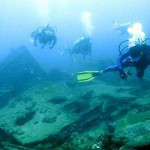 Even local divers are willing to pay money to experience the adventure of diving at a historic shipwreck as well as seeing beautiful corals and reef fish. Unfortunately due to other constraints, especially work-related ones, I was not able to experience this myself.
Even local divers are willing to pay money to experience the adventure of diving at a historic shipwreck as well as seeing beautiful corals and reef fish. Unfortunately due to other constraints, especially work-related ones, I was not able to experience this myself.
A few months ago the story of this shipwreck was unexpectedly brought to the limelight thanks to a tragedy. Not knowing the historic value of the wreck, the Government Agent of Galle had given permission to break it up for iron to some looters. The looters got this permit by showing some other, more recent, wreck, but their intention was to break the Conch for iron. The local diving centres of this area stood against this move long before the Department of Archaeology and other authorized agencies took any action. In fact they are the people who alerted the relevant institutes regarding the issue. To stop this permanently and legally we needed some evidence to prove the archaeological value of this wreck.
The wreck is known among the divers of Hikkaduwa area as the SS CONCH, the first oil tanker (oil transportation ship) to sink. this was in the year 1903. It is said that the oil tanks are still visible, and also that the CaptainÔÇÖs cabin is still intact and accessible. The main
problem, however, was the lack of historical evidence to confirm these commonly held views.  I had to investigate further because oral history alone would not be enough to prove the archaeological significance of this wreck.
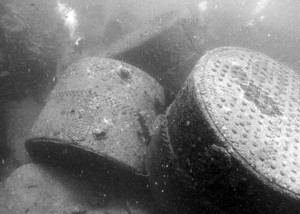
At the same time I had the opportunity to visit the Conch. I went to the site with the divers from the Blue Deep Dive centre. We launched a boat from the Hikkaduwa beach and took it parallel to the coast line until we reached the Akkurala area. It was a 10 km journey and took nearly half an hour. We anchored the boat near a small rock rising out from the water (villagers called it as the ÔÇ£Passa galaÔÇØ rock) which is situated 03 km from the beach. The depth gauge recorded 17 when we reached the bottom. The visibility was nearly 15 meters, more than enough to inspect the wreck. Hundreds of iron parts of the shipwreck were scattered all over the sea bed. It was very hard to get an idea of the shipÔÇÖs structure at this point.
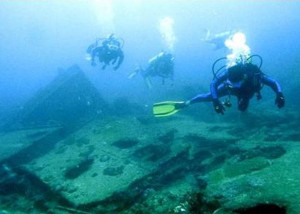
Then the divers took me to the stern section of the Conch. That was the deepest cialis order part of the wreck. The depth was 21 meters. On the sand bottom the half buried propeller showed the tail end of the wreck.(see the cover page) A big section of the stern side of the hull was lying on its port side.(see the cover page)┬á The engine room situated at the back of the ship was completely broken open. We were able to see clearly the steam engine, proper shafts and the levers. Since the finest metal and alloys had been used for the engine, they are still free of deep corrosion.(Fig 5 & 6) Three large boilers of the ship were placed near the steam engine. They were still in good shape.(Fig 1) Most of the divers are in the practice of describing these three huge boilers as oil tanks of the Conch. This, however, is not true. Also, the inside part which they described as the CaptainÔÇÖs cabin is also a case of misinterpretation. It was a section of the hull which has turned completely upside down, still intact, and making a cave of 12 x 8 meter dimension. The light enters to this dark room only through a few holes in the steel panels. There were a lot of fish gathering inside this dark and safe cave. ┬áIt was a pleasant experience to go across this dark cave through the fish. We could clearly see the deck pillars and the ribs of the hull inside this part.┬á (Fig 3)
It took us a long time to check the wreck and get a general idea. It was spread over a large area; approximately 100 x 35 meters. There was clear evidence to verify that the Conch broke in two when it sank after hitting the reef. She was resting on her port side. The depth was 14 meters near the Bow section. The hull was broken into small pieces around this area. There was clear evidence to the effect that the disaster happened due to explosion/dynamite. (Fig 7)
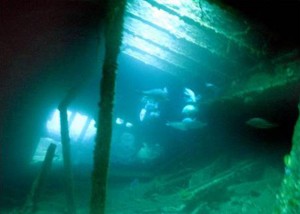
When I was searching for more evidences about the wreck, a person from one of the diving centres in Hikkaduwa (Poseidon Diving Centre) told me that he came across some details about the SS Conch when he was visiting the Liverpool Museum in the United Kingdom. With this clue I immediately wrote to the museum. After a few weeks I got an answer from Merseyside Maritime Museum, National Museums of Liverpool, UK. It was a very short description, but indeed an important one. They have sent me a small paragraph from a book named ÔÇ£Disasters at Sea during the Age of SteamÔÇØ and it says:
ÔÇ£CONCH Shell Transport & Trading Co,; 1892; W. Gray & Co.; 3,555 tons; 338-4x43x26-4; 324 n.h.p.; triple-expansion engine. The British tanker Conch was wrecked on June 3rd, 1903, on Akurata Rock, Ceylon. She was on a voyage from Novorossisk and Colombo to the Madras coast.ÔÇØ
This constituted more precise and acceptable information and enabled me to go ahead with the research. With the exact date sent to me I searched in the Department of National Archives and the internet. At the end I managed to find the whole story about the SS Conch and its wrecking. Most of the details I found were in the newspapers published in 1903.  This incidence was well reported in the Ceylon Observer.
The Ceylon observer Wednesday evening June 3, 1903 : Page 05
A shell line steamer runs ashore of the Ceylon coast .
The Petroleum vessel ÔÇ£ConchÔÇØ in trouble.
The shell line steamer ÔÇ£ConchÔÇØ left Colombo harbour last night with large cargo of several thousand tons of bulk oil consigned to Madras . The local agents Messrs, Delmege, Forsyth & Co., received telegraphic information this morning that she had run ashore on the rocks near Ambalangoda and the firmÔÇÖs Engineer, Mr. Bank, proceeded to the spot promptly to ascertain the extent of the damage and how much the ship had suffered. Enquiry of the local Agents this afternoon failed to elicit definite information as to the state of the vessel, but the wreck is supposed to have taken place during the night- a currant presumably taking the vessel closer to the rock-bound coast than was safe enacting another disaster like that of the ÔÇ£UmonaÔÇØ in the Maldives.
The news at Galle – Galle, June 3, 3 p.m.
Information was received here late this morning by Messers, Clark Spence & Co., Lloyds Agents, that the steamer has been wrecked at Akurella between Ambalangoda and Hikkaduwa. Mr. H. C. Peterson, of Clark Spence & Co., Mr. Titley, of Messeas, Coates & Co., the Master Allendant, Mr. Twynam and some Police, have gone to the scene. The crew are expected here there are no further particulars as yet. – By telegraph.
The Ceylon observer, Wednesday evening, June 4, 190 3 : Page 05
The ss ÔÇ£ConchÔÇØ a total WRECKS:
Abandened by officers and crew.
The vessel dissepiering from sight. – Galle June 4, 11.45 a.m.
The steamer ÔÇ£ConchÔÇØ captain Mackenzie, Shell Transport Trading Company bound from Colombo to Madras with petroleum bulk, went on rocks at Akuralla village, midway between Ambalangoda and Hikkaduwa. Close as possible at 12.35 a.m. on the morning of the 3rd. the second officer was in charge at that time. The sea was heavy, but it was not at first thought the steamer would be lost.
Several boats went to the rescue of the crew. – But it was not thought that help was needed till noon yesterday. When all hope was lost and the lascar crew with the European officers landed safely. But nothing much could be brought off the vessel. Messrs, Brodhurst, Twynam, Titley, Paterson and others from Galle were promptly on the scene. Messrs Coates & Co., Local Agents, arranged accommodation for the 13 officers and crew housed elsewhere from the present position of the vessel.
No possible hope is Entertained – of her being refloated. Her bow is entirely down and extreme portion of steam with one mast is only seen and ever this is fast disappearing. The oil from the tanksby some mean got out and the water far miles are almost impassable owing to strong smell.
Officers and some of the crew at Galle later. – The officers and some of the crew of the Steamer ÔÇÿConchÔÇÖ arrive this noon by train from Ambalangoda. Mr. Brodherst, Receiver of the wrecks, held an inquiry at the Costumes office today, when the Captain, Second Officer, Third Office, Quarter-Master and the men at the wheel were examined. Mr. Twynan, Assistant collector and Mr. Paterson of Massrs Clark Spence & Co. were also present -┬á By Telegraph
Breaks into two amidships and goes under.
Oil cargo ÔÇô valued at ┬ú 15 000 ÔÇô Lost
We mentioned yesterday the disaster that befell the Shell line steamer ÔÇÿConchÔÇÖ which ran on the rocks at Akkurala reef, near Ambalangoda on Thursday night on her voyage from Colombo to Madras with a cargo of several thousand tons of bulk oil for the latter part. Mr. W. Bank, engineer of the local agency (Messrs, Delmage, Foreyth & Co., went down to the seen of the disaster by Train yesterday and return to Colombo . About noon today the Colombo Agents received the direfu intelligence that the vessel had gone under altogether. The news, which was despatched at 10.5 am , was as follows.
–The ÔÇÿConchÔÇÖ is broken in half amidships. No salvage possible. The ship is submergedÔÇØ
through the great danger in which the vessel was fully appreciated this intelligence has come as a very unpleasant surprise, especially as there is now no hope whatever of doing anything in the matter Mr. Baak assarts that there has been a very high sea running all the time and there heavy surf┬á both and also crew was,ÔǪ..ÔÇØ
None of these reports said anything about the uniqueness of this shipwreck. Such information was however available on the internet. Yes, it was one of the worldÔÇÖs first oil transporting ships. Also there was another interesting story hidden behind this. It was about two brothers who were in sea shell business and later became the owners of the well known Shell Corporation.

When the family business M. Samuel & Company was taken over by Marcus and his brother Sam it was quite strong as over the years
their father had made numerous connections in the Far East. At that time their main trade was in exotic sea shells and had nothing at all to do with oil. The shells were very popular in Britain and in London; they employed about 40 girls in making shell-boxes (souvenir ornament boxes) decorated all over with rear shells. Along with this shell business slowly they start to trade semi precious stones, rice, grains and sugar. They occasionally added some kerosene tins to their goods. At that time the oil/kerosene was transported in tin cases. It was normally rectangular tin cans containing 5 US gallons with two cans packed in a wooden case. At the time oil transporting ships had to sail around the Cape of Good Hope to reach the Atlantic Ocean. The Suez Canal co. did not then permit the transport of case oil through the canal on the ground of safety, although it was a very profitable trade. During the late 1880ÔÇÖs the Samuels had this idea to get in to the Far Eastern oil market on their own account and to use their own ships to carry their own Kerosene. But he was not interested in case oil; his idea was to transport bulk oil. In doing that they had to deal with some major problems. First they had to make new ships with tanks to carry oil safely. Then they had to demonstrate the safety of these ships to the Suez Canal Co. and obtain a new agreement to go through it. Most of all they had to do all these things in secret, because Standard Oil Corporation, which enjoyed a virtual monopoly in this trade, could very well destroy or absorb any competitor.
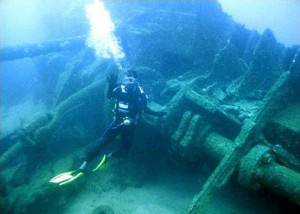
By getting together with Fortescue Flannery, a marine engineer, young Marcus designed four ships with large oil tanks inside.┬á At the end of June 1892 they had built four ships under the W. Gray & Company in Stockton. Because of their relationship with sea shells Marcus named them as MUREX, CONCH, TURBO and CLAM. These were FlanneryÔÇÖs personal triumph; to counter the risk of grounding in the canal, he gave them water ballast tanks, which could be de-ballasted to lighten if required. To counter the risk of collision, which could rupture the oil tanks, he placed these amidships, with coffer-dams, an empty space, at each end. This isolated the tanks from the boiler room and engine room aft, as well as from the fore hold and empty fore peak forward. Coal bunkers were located both sides of the boiler room close to where they would be needed. To allow for the expansion of the oil as the vessel sailed from the relatively cold Black Sea to the rather warmer Far East, there were expansion tanks built into the top of each tank. To reduce the oilÔÇÖs sideways movement, which could seriously endanger the shipÔÇÖs stability, an oil tight bulkhead ran fore-and-aft through the centre of the each tank limiting the free surface effect. Loading and discharge was exclusively by the pumps, lightning was exclusively by electricity; and a device was arrange to steam clean the tanks thoroughly after discharge, so that no potentially explosive residue would be left. Modern tankers are still designed in basically the same manner.
Actually MUREX was the first ship to put in to the water. By 26th July 1892 it was completed and under Captain John R. Coundon, set sail for Batum (BatÔÇÖumi or Batum, city in southwestern Georgia , capital of Ajaria autonomous region, and a port on the Black Sea, near Turkey . BatÔÇÖumi is a transport center for petroleum from Baku , Azerbaijan , with which it is linked by rail and by pipelines. It was part of the Ottoman Empire from the 16th century until 1878, when it passed to Russia following the Russo-Turkish War.) There she loaded a full cargo of Russian Keresene and on 24th August 1892 she passed through the Suez Canal, the first bulk oil tanker to do so. The CONCH was also put in to the business immediately after the Murex. ┬áAfter starting this profitable oil transportation, on the 18th October 1897, the Samuels changed the name of their company to THE SHELL TRANSPORT & TRADING CO. On the 1st January 1907 the Shell Transport and Trading Co. amalgamated with the Royal Dutch Petroleum Co. to become the Royal Dutch Shell Group of companies.
According to the archives SS Conch weighted 3,555 tons and 338 x 43 feet in dimension. It had a 324 N.H.P. (nominal house power) triple-expansion engine. Still there is some doubt about the number of the oil tanks in the Conch. As far as the Murex is concerned, it clearly stated that there were about five tanks, but thereÔÇÖs no such information about the Conch.
The archival evidence speaks of four tanks but it is not very clear. We still havenÔÇÖt been able to find any blue prints or clear information about the exact position of these tanks. Unfortunately the same part (from amidships to bow) was heavily damaged during the wrecking and by the explosions. Local divers told me even before 1995 the wreck had been heavily damaged by dynamite. But this was stopped eventually after the wreck became a tourist attraction. Most of the deck pillars (easily removable) had already been pulled off for iron. (Fig 2, 6 & 7)
[/fusion_builder_column][fusion_builder_column type=”1_1″ background_position=”left top” background_color=”” border_size=”” border_color=”” border_style=”solid” spacing=”yes” background_image=”” background_repeat=”no-repeat” padding=”” margin_top=”0px” margin_bottom=”0px” class=”” id=”” animation_type=”” animation_speed=”0.3″ animation_direction=”left” hide_on_mobile=”no” center_content=”no” min_height=”none”]
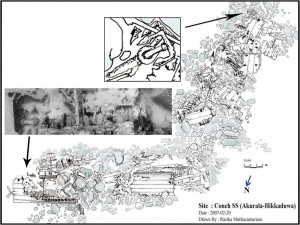
For future purposes I drew a rough site plane for the Conch. Due to the lack of time, I took lots of photographs and with their help, later added some details into the plan.(Fig 6) These plans, records and the archives will help prove the significance of this site and establish the need to protect it from further disasters.
The Police and the Department of Archaeology, using the laws pertaining to land archaeology have succeeded in keeping things under control for the moment. In this regard the Department of Archaeology used the Antiquities Amendment, 1998. (Existing law for monuments over 100 years old)
ANTIQUITIES ORDINANCE (Chapter 394) 15th July, 1940.
Part i
i (3) All undiscovered antiquities (other than ancient monuments), whether lying on or hidden beneath the surface of the ground or in any river or lake, shall be deemed to be the absolute property of the state, subject to the provisions of this ordinance.
Part iii
Ancient Monuments
Part iii 16.(1) The Minister may by order in writing declare that any specified monument which dates or is believed to date from a period prior to the 1st day of January, 1850,shall, notwithstanding that such monument does not is not believed to date to a period prior to the 2nd day of March 1815,be deemed to be an ancient monument for the purpose of this ordinance.
(2) Upon the publication in the Gazette of an order under subsection (1), the monument to which the order relates shall be deemed to be an ancient monument and all the previous of this ordinance relating to ancient monuments shall apply to that monument as if it were an ancient monument.
ANTIQUITIES (AMENDMENT) Act, No. 24 OF 1998
5. Section 16 of the principal enactment is hereby amended as follows:-
(1) in subsection (1) thereof, by the substitution for the wordsÔÇØ which dates or is believed to date from a period prior to the 1st day of January 1850, shallÔÇØ, of the words ÔÇ£which has existed or is believed to have existed for a period of not less than hundred yearsÔÇØ.
(2) in the marginal note to that section, by the substitution for the words and figures ÔÇ£ dating to period prior to 1850ÔÇØ, of the words ÔÇ£in existing not less than hundred yearsÔÇØ.
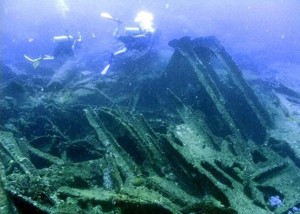
There are several reasons why the SS Conch should be considered a significant archaeological site. Without any question, it is an archaeological monument/site within the limits of a historical time frame and located within our territorial sea. It provides an interesting and appropriate training site for future maritime archaeological work. It can also be used in highlighting the necessity to ratify the 2001 Convention (UNESCO convention for protecting the underwater cultural heritage) and put it into action.┬á It also gives us an opportunity to strengthen dialogue with local diving communities in the matter of conserving marine archeology, exchanging ideas and experiences and incorporating this extremely valuable human resource in the management and protection of Sri LankaÔÇÖs underwater cultural heritage.
By Rasika Muthucumarana
Maritime Archaeologist
Maritime Archaeology Unit ÔÇô Central Cultural Fund ÔÇô Galle ÔÇô Sri Lanka



I saw the following on the internet site : http://freepages.genealogy.rootsweb.ancestry.com/~stormrhb/clarks.htm
Are they refering to the same SS Conch?
Lothian Clark 1886-1916 SS Conch First Officer
SS Conch was built by Swan Hunter at Wallsend in 1909 as a bulk tanker for the Anglo Saxon Petroleum Co Ltd, (Shell), hence the name. Like all early tankers the bridge and officer accommodation was amidships with the engine room and crew quarters at the stern. She weighed 5620 tons gross.
Her final voyage began when she left Tilbury on 28th October 1916 for the Far East, where they coasted for several months calling at Singapore and Calcutta among other ports. The shipment of liquid benzene for the voyage home was loaded at Rangoon They left on 27th October 1916 bound for Thameshaven
The following is a summary of events taken from two statements the Chief Engineer of the SS Conch, who survived the sinking, gave to the Board of Trade and Admiralty within four days of the sinking.
The Conch called at Gibraltar on 29th November to receive route instructions for the passage to London. Warnings of submarine activity in the English Channel had been picked up by wireless on 6th December.
All went well with the ship proceeding at 10 knots until somewhere off Portland Bill at about 10.30 pm on 7th December when a sudden explosion shook the ship, which listed to port and then righted itself. The Chief Engineer immediately went to the engine room and found everything in order with the 4th Engineer on watch. He called the other two engineers who reported that the ship was ablaze. The explosion must have ruptured the tank tops and sent a column of burning oil over the bridge. Telegraph contact with the bridge was tried but no reply was forthcoming. The Chief Engineer believed that all on the bridge would have been killed instantly. The engineers kept the ship going to prevent burning oil collecting round the ship. Four Chinese crew members also took shelter in the engine room.
They remained below until about 12.30 am when the 2nd engineer managed to get out through the stokehold and everyone else followed. The bridge was totally burned out and the forward tanks were still ablaze. All the lifeboats had been swung out earlier as a precaution, but all of them were gone. The Chief Engineer was not sure if men had escaped in them or they had been burnt.
A small boat was found in the well deck and they got it into the water. The Chief Engineer and the Chinese got in but the 4th Engineer drowned in the attempt as his hands were so badly burned that he could not hold the rope. The rope then broke and the boat drifted astern of the ship which was still proceeding up Channel with the other two engineers aboard. They made a raft and jumped overboard at about 4.00 am and were picked up later.
The Chief Engineer and his Chinese companions were picked up at about 2.0 am by SS Rattray Head, which also rescued a further five Chinese crew. When last seen by the Chief Engineer the Conch was well down at the bow and gradually sinking. The Chief engineer was unable to confirm if the explosion was caused by a torpedo or a mine.
German documents claim that the Conch was torpedoed by submarine UB 23. Although she was hit off Portland Bill, she travelled a further 20 miles to 12 miles off St Albans Head, near Swanage before sinking. A total of 28 lives were lost.
i was fascinated by this news. thanks to this wonderful guy who took so much of effort to give such a valuable report and the other person who added more to it.
i hope ppl like me who cannot dive, would have enjoyed this info.
i highly appreciate your work, sir.
a big “THANK YOU”.. btw, i’ve heard that there are more shipwrecks in the sea in trincomale, for your information.
Comments are closed.